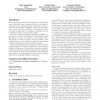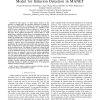3071 search results - page 168 / 615 » Explanatory Design Theory |
130
Voted
SDB
1995
15 years 2 months ago
1995
Most of work on partial information in databases asks which operations of standard languages, like relational algebra, can still be performed correctly in the presence of nulls. In...
103
Voted
ATAL
2010
Springer
15 years 21 hour ago
2010
Springer
In many multiagent settings, situations arise in which agents must collectively make decisions while not every agent is supposed to have an equal amount of influence in the outcom...
116
Voted
GECCO
2008
Springer
14 years 12 months ago
2008
Springer
In this paper, a multiobjective (MO) learning approach to image feature extraction is described, where Pareto-optimal interest point (IP) detectors are synthesized using genetic p...
182
Voted
TDSC
2011
14 years 5 months ago
2011
—In this paper, we study leader election in the presence of selfish nodes for intrusion detection in mobile ad hoc networks (MANETs). To balance the resource consumption among a...
74
Voted
CHI
2011
ACM
14 years 2 months ago
2011
ACM
When designing questionnaires there is a tradition of including items with both positive and negative wording to minimize acquiescence and extreme response biases. Two disadvantag...



